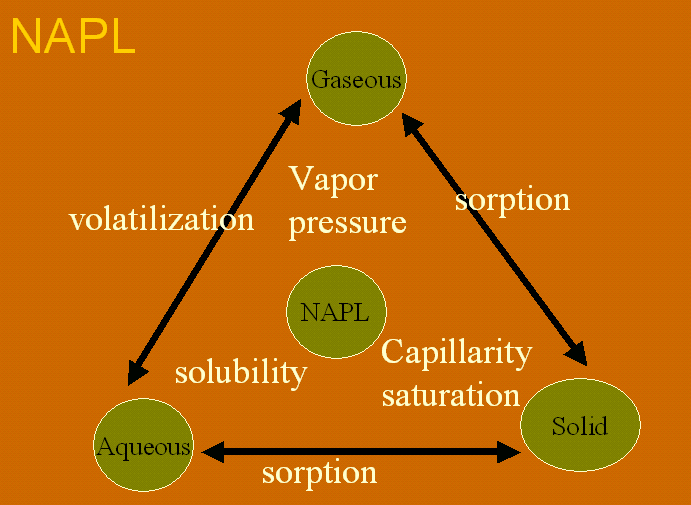
Bioventing
We often refer to contaminants in soil as non-aqueous phase liquids (NAPL, "nap ill"). The behavior of NAPL is complex and highly dependent on the contaminant and soil. Soil above the water table is a mixture of soil particles, water, and air. The water and NAPL exist between the soil articles, in interstices of the particles, and clinging to them. Here is a diagram of the relationships and processes:

The NAPL will partition between the phases. Based on physiochemical process, the NAPL will reach an equilibrium where it will remain at constant concentration for a long time, decreasing slowly as rainwater periodically replaces the saturated water with unsaturated water. Physiochemical process of treatment might include forcing water through the soil, but forcing air - venting- is more common.
The process of bioventing involves forcing air through the soil. At first this shows a large reduction in contaminant concentrations, as the volatile components of the contaminant leave with the air. If conditions are right, or made right by treatment, the next phase involves an increase in the metabolism (or respiration) of aerobic microorganisms. These take the NAPL and "mineralize" it, i.e., change it into carbon dioxide and water vapor. The organisms also multiply and convert the NAPL into biomass. Here is an EPA document, read the first two chapters, then I suggest you skim the rest of it. EPA Bioventing. While the principles are fairly straight forward, the hardware and many details of the method will vary quite a bit. Testing to determine if the Bioventing is working may be done by measuring the respiration of the organisms. You can see a little of the procedures used in Chapters 4 and 5 of that document. A slightly more technical description of "respiration testing" in found in Corps Bioventing Chapter 4 on pages 4-27 and following pages.
With respect to soil piles, often pipes with diffusion holes are buried in the pile and air forced through these. The principles are the same.
There is an analogous process called "soil vapor extraction" where the primary goal is removing the vapors and biological processes are assumed not important. Sometimes the expression "Bioventing/soil vapor extraction" is used to indicate both processes are taking place. If you have volatile and a contaminant that aerobic bugs eat, of course you will have both processes, and the difference is semantic.
Before we leave, I should mention:
Other sources of oxygen are sometimes used, hydrogen peroxide and permanganates are two. Expense is usually the determinant.
Some NAPLs become more amenable to biological action if a dispersant or solvent is added.
A few words about "underground injection." This is a gross option that is usually avoided and hard to get a permit for. Its principle decent use is for the extractive industries, salt and petroleum, that generate waste - drilling muds - that they are allowed to pump back into the hole when they are done with them. You'd be horrified to know that pumping all sorts of HW underground was allowed until relatively recently, as long as the injection well was "at least one quarter mile from a drinking water aquifer."